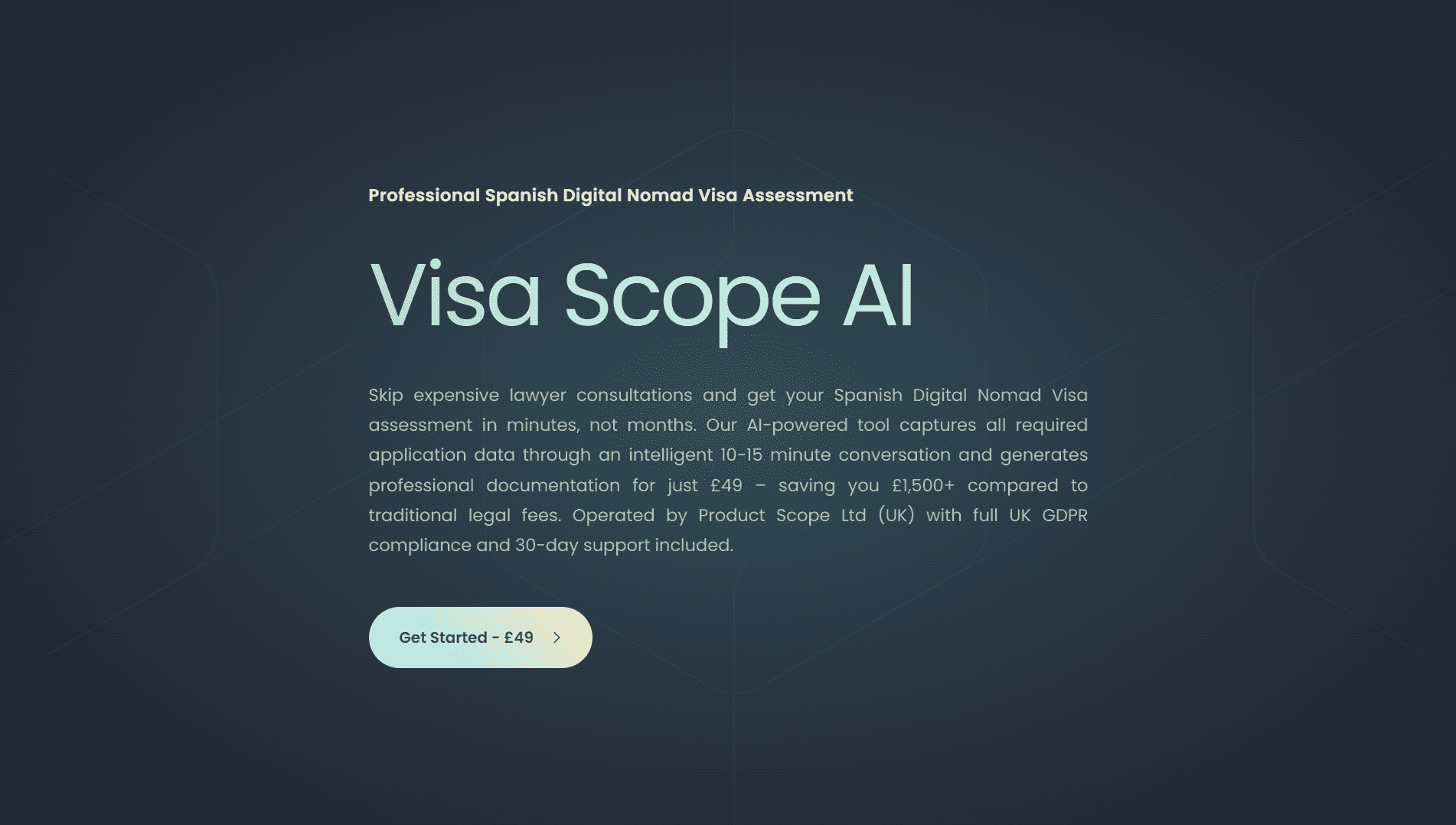Building Visa Scope AI, Part 1: From Problem to No-Code Plan
Building Visa Scope AI, Part 1: From Problem to No-Code Plan
I had noticed that more and more job descriptions for a freelancing site I subscribe to were asking for no-code/low-code solutions. I was dubious as to whether linking together a range of SaaS products could actually deliver robust workflows that businesses could use. After a chat with some developer colleagues who challenged me to find out, I decided to take them up on it. As a Product Manager, I am someone who thrives on challenges and learning new tools, so I thought I’d give it a go.
The result is Visa Scope AI, an automated tool that uses AI to assess Spanish Digital Nomad Visa eligibility. Through a conversational interface, it gathers applicant information, validates requirements, and generates a professional assessment PDF—all without human involvement. My research discovered a significant market gap: lawyers were charging thousands for basic intake consultations, but no automated tools existed to help visa applicants. I decided to skip the B2B approach and go direct-to-consumer at £49.
Over the course of three articles, I’ll explain how I built this from scratch without development input. In this first part, I’ll cover how I discovered the problem, validated the market opportunity, and selected the technology stack.
Having successfully completed the Spanish Digital Nomad Visa application myself, I’d spent hours on calls with lawyers and read through all the complexities of the application process. When I contacted lawyers to take my case, I experienced lots of WhatsApp messages, emails and back-and-forth before even booking the initial consultation. This took significant time and I realised it must take lawyers or their assistants huge amounts of resources just to provide initial information. Despite being organised and supplying all the details ahead of consultations, I noticed lawyers taking notes in pencil and wondered how this would all be reconciled when a client was onboarded.
I saw an opportunity to use AI to collect the initial client details, ask additional questions to challenge and find out more about case complexities and provide simple validation on hard visa requirements such as salary or work location. It seemed like the perfect test case for a low-code workflow solution. I set a budget of around £300 in system costs to get an MVP working and ready.
Before building anything, I needed to validate whether this solution had real commercial potential. The numbers were encouraging as the Spanish Digital Nomad Visa programme, launched in 2023, had already attracted 37,787 visa holders as of June 2025. The visa’s accessible income threshold of €2,763/month (approximately £2,400) and five-year residency pathway made it particularly attractive to remote workers seeking European residency.
But the application process presented a significant barrier. Immigration lawyers were charging £1,500-3,000+ for full consultation and application services, with some requiring multiple meetings over several weeks just to gather basic information and prepare documentation. This created a prohibitive cost barrier for many qualified applicants.
My competitive analysis revealed a crucial finding: no automated competitors existed. The market consisted entirely of four categories:
– High-tech B2B tools (like Parley and Visas.AI) that served lawyers, not consumers
– Simple travel visa platforms (like Atlys) that handled tourist visas but lacked the legal sophistication for complex residency applications
– Human-led nomad services (like Nomads Embassy and MigRun) that validated demand but remained expensive and manual
– Generic information websites that provided content but offered no application assistance
This was my opportunity to create a professional-quality AI-powered assessment service that could deliver the same comprehensive information gathering that lawyers provided during expensive consultations, but at a fraction of the cost and with instant results.
The visa intake process is fundamentally systematic as immigration lawyers ask structured questions, probe for clarification, assess eligibility criteria and prepare documentation guidance. These are processes that AI can execute consistently through conversational interfaces. The Spanish Digital Nomad Visa has clear, documented requirements that can be validated programmatically such as income thresholds, work arrangements, insurance coverage, criminal record checks.
My initial concept had been to build a B2B SaaS tool for immigration law firms. The concept was essentially a productivity tool to help lawyers gather client information more efficiently. However, my research led me to make a fundamental strategic decision to pivot to direct-to-consumer.
My reasoning was that whilst law firms might pay for productivity tools each sale would be hard won and I wasn’t sure that lawyers, who were used to working on paper would be willing to change their process or pay much for an automated process. I decided the real market opportunity was serving the visa applicants directly. By cutting out the lawyer intermediary for the initial assessment phase, I could reach a much larger market, deliver clearer value (£49 versus £1,500-3,000) and validate AI capability without navigating law firm sales cycles.
This pivot changed everything about how I would build and market the product. I wasn’t creating a lawyer productivity tool anymore I was building a consumer-facing AI legal assistant that needed to inspire trust and deliver professional-quality results without human oversight.
With the B2C model decided, I needed pricing that would both attract customers and prove business viability. My competitive analysis made this straightforward.
Traditional immigration lawyers charged £1,500-3,000+ for full services, with initial consultations costing £80-100. My reasoning was that AI-powered processes are cheaper to produce than human services, so I needed to charge less than a consultation but enough for customers to see real value in the assessment.
At £49, I positioned Visa Scope AI between free information websites (no personalised guidance) and expensive lawyer consultations (which many find unaffordable). The price validated customer seriousness whilst remaining accessible to remote workers earning the €2,763+/month visa threshold.
Rather than focus on volume or client acquisition, the core aim was to deliver the end-to-end workflow. I wanted to learn what was possible and validate whether the concept had legs before investing further resources.
I refined the MVP to build a self-service process using no-code SaaS services. An AI agent would have a conversation with customers, collect their information, structure it according to visa requirements and output a professional summary all without human intervention.
The AI agent would ask qualifying questions to determine eligibility, gather information through intelligent conversation, and generate a comprehensive PDF containing eligibility assessment, documentation checklist, timeline guidance and next steps.
If this initial process could be validated, I’d have the data to decide whether to take the product to market or simply document the learnings for future implementations. The PDF needed to be professional enough that customers would feel confident using it with proper formatting, clear sections, personalised guidance, and language that balanced accessibility with authority.
My first decision on the product was to use AI to assist me. I had recently started using Claude and I wanted to test the capabilities (I always use ChatGPT as well). Before I started the build, I wanted to validate the concept and workflow on paper.
I decided that I needed the following components: website, CRM, payment processor, connection product, AI tool, PDF generator, and email delivery.
I sketched out a workflow using AI to assist me and spent the first week of the project selecting systems, writing up the aims of the project in Confluence, and writing Jira implementation tickets for myself.
Some systems were easy to select. I went with Carrd for the web provider purely on ease of use and price point: $19 per year. I decided to use Zoho CRM as I have experience with the product and I didn’t want to slow down the project learning a new CRM.
At one stage, AI was suggesting I use multiple products in the Zoho suite, which could handle the CRM, the sending of emails, and the PDF generation. Initial workflows were positioning the use of Zoho Form, Zoho Creator, Zoho Mail, and Zoho Flow, and I also nearly subscribed to Zoho One. But after more research, I pulled back. I had already delivered a big project in the Zoho ecosystem and I found Zoho Flow, in particular, limiting, especially when it comes to custom functions, as using their Deluge script is challenging and the instructions are not complete.
So I decided against the Zoho all-in approach and selected Make.com as the connection product, which is a decision I’m very happy with, but I’ll discuss Make in more detail in upcoming blog posts.
Stripe was a given for payments. It’s not only the most versatile provider but I use it in products I manage for my main client and although I have a good understanding, it’s not something I’ve integrated myself, so having more knowledge of setup was a big bonus.
I toyed with using Zoho Mail as it’s cheaper and was a new mail tool I’ve not used previously but the commitment was 12 months and I was told deliverability was not as good. When looking at how to create the PDFs I realised I could create the template in Google Docs, save as a PDF, and then send using Gmail. This was a deal-breaker for me as I got all of the delivery functionality and the PDF generation for one price, plus better deliverability. Google Workspace was selected as the delivery tool.
This only left one item, which was the AI. I spent the majority of my time researching this and initially I selected Landbot, mostly due to price and the fact that it could hold information from a chat. Still, at €40 a month, it’s my most expensive solution.
The platform decisions were driven by three factors, monthly cost (£300 budget for the project), technical capability (each tool had to do its job well) and ease of implementation (I’m not a developer by trade).
Make.com over Zapier: 10,000 credits at £10/month. Zapier’s comparable tier would cost significantly more as complexity grew. Make.com became the central nervous system connecting all systems.
Google Workspace over Zoho Mail: No 12-month commitment for an unproven MVP. Google Workspace’s £6/month bundled Gmail (professional delivery), Google Docs (PDF generation), and Drive (storage) in familiar tools.
Landbot for AI conversations: After researching Landbot, ChatBase, Voiceflow, and others, Landbot’s €40/month plan offered conversational AI building with conditional logic, data validation, and API integrations. The conversational interface was more engaging than forms and Landbot could probe for clarification matching how lawyers conduct intake.
My final monthly stack looked like this: Carrd at £1.58/month (£19/year), Stripe variable per transaction, Make at £15/month, Landbot at £36/month (€40), Zoho CRM at £0 (free tier), and Google Workspace at £6/month.
Total: £68/month (plus Stripe fees). At £49 per customer, I needed just two customers monthly to break even.
With research validated, strategy defined, platforms selected, and success criteria clear, I was ready to start building. The question remained: could these no-code platforms actually deliver on the promise of professional-quality automation?
In Part 2, I’ll cover the actual build: setting up domains and Stripe, the security gateway challenge, the Zoho Creator failure that cost me 6 hours, the JavaScript pivot, the week-long Landbot integration breakthrough, and the PDF generation pipeline—including all the mistakes and lessons learnt along the way.







